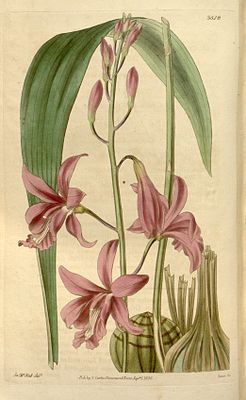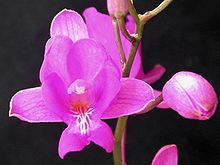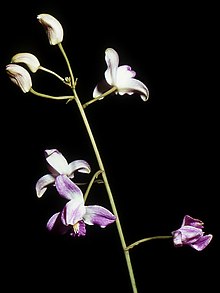Bletia
| Bletia | ||||||||||||
|---|---|---|---|---|---|---|---|---|---|---|---|---|

Bletia patula , illustration from Curtis's Botanical Magazine |
||||||||||||
| Systematics | ||||||||||||
|
||||||||||||
| Scientific name | ||||||||||||
| Bletia | ||||||||||||
| Ruiz & Pav. |
The genus Bletia from the family of orchids (Orchidaceae) includes 35 plant species , all of which occur in tropical America. The plants grow terrestrially in savannahs or, less often, on the edge of water. They are occasionally cultivated because of their large flowers .
description
All species of this genus form sprouts at a short distance that are thickened to rounded tubers . The few roots are fleshy and surrounded by a velamen of three to four layers of cells. The tubers are usually located just below the surface of the earth. They consist of several internodes . At the top there are two to four leaves . The leaves are oblong-oval, thin and folded along the numerous protruding leaf veins . At the base they run out in a wedge shape into a petiole. They can reach a length of half a meter to a meter.
The upright inflorescence emerges laterally from the base of the sprout tubers, either from below the leaves or enclosed by leaves at the base. It is racemose or slightly branched, towers over the leaves and bears up to 50 flowers. The flowers of an inflorescence bloom from the bottom up. The resupinated flowers are colored red, pink, white or yellow. The three sepals are almost the same shape and not grown together. The lateral petals are often much wider than the outer petals, sometimes they lean forward and encircle the column . The lip is three-lobed, attached to the column at the base. The two side lobes stand upright, the middle lobe ends bluntly or is again divided into two lobes. A callus made up of several keels runs lengthways on the lip . The slightly curved column is winged and has no foot. The stamen is terminal and contains eight soft or hard pollinia . Four each sit in a compartment one above the other.
Some species are known to be pollinated by bees .
distribution
The species of the genus Bletia occur from the northern edge of the American tropics in Florida and Mexico across Central America to southern Brazil and northern Argentina . The locations are mostly light pine-oak forests, savannas and grasslands with a dry season at altitudes from 0 to 2700 meters. Some species occur on moist river banks and in the tropical rainforest , some also in dry thorn bushes. The greatest biodiversity is found in Mexico.
Systematics
Within the subfamily Epidendroideae , the genus Bletia is classified in the subtribe Bletiinae. While Dressler places these subtribes in the Arethuseae tribe , other authors see them in the Epidendreae and reduce the related genera in the Bletiinae subtribe to Hexalectris and Basiphyllaea . Type species of this genus is Bletia catenulata .
The following species and three natural hybrids in this genus have been described:
- Bletia adenocarpa Rchb.f. , Mexico.
- Bletia altilamellata Garay , Colombia, Guiana
- Bletia amabilis C. Schweinf. , Mexico.
- Bletia antillana M.A. Diaz & Sosa , Cuba.
- Bletia campanulata Lex. In P.de La Llave & JMde Lexarza , large area from Mexico to northern Argentina.
- Bletia candida Kraenzl. , Colombia.
- Bletia catenulata Ruiz & Pav. , Northern Andes from Colombia to Bolivia and east to Brazil.
- Bletia coccinea Lex. In P.de La Llave & JMde Lexarza , Mexico.
- Bletia concolor Dressler , Mexico.
- Bletia ensifolia L.O.Williams , Mexico.
- Bletia florida (Salisb.) R.Br. in WTAiton , Cuba and Jamaica.
- Bletia gracilis Lodd. , Mexico to Guatemala.
- Bletia greenmaniana L.O.Williams , Mexico.
- Bletia greenwoodiana Sosa , Mexico.
- Bletia lilacina A. Rich. & Galeotti , Mexico.
- Bletia macristhmochila Greenm. , Mexico.
- Bletia meridana (Rchb.f.) Garay & Dunst. , Venezuela.
- Bletia mixtecana Salazar & C.Chávez : The species first described in 2016 occurs in the Mexican state of Oaxacana .
- Bletia neglecta Sosa , Mexico.
- Bletia nelsonii Ames , Mexico.
- Bletia netzeri Senghas , Dominican Republic.
- Bletia parkinsonii Hook. , Mexico.
- Bletia patula hook. , southern Florida and the Caribbean.
- Bletia punctata Lex. In P.de La Llave & JMde Lexarza , Mexico.
- Bletia purpurata A. Rich. & Galeotti , Central America.
- Bletia purpurea (Lam.) DC. , from southern Florida and Mexico south to Peru, Bolivia and Brazil.
- Bletia reflexa Lindl. , Central America.
- Bletia riparia Sosa & Palestina , Mexico.
- Bletia roezlii Rchb.f. , Central America.
- Bletia stenophylla Schltr. , Venezuela, Colombia and Ecuador.
- Bletia tenuifolia Ames & C. Schweinf. , Mexico.
- Bletia urbana Dressler , Mexico, the population is endangered.
- Bletia villae Soto Arenas , Mexico.
- Bletia warfordiana Sosa , Mexico.
The list of the Kew Botanical Garden names the large number of 160 synonyms.
With the hybrids:
- Bletia × ekmanii Serguera & Sánchez Los. , Mexico = ( Bletia patula × Bletia purpurea )
- Bletia × similis Dressler , Mexico = ( Bletia adenocarpa × Bletia concolor )
- Bletia × tamayoana S.Rosillo ex Soltero , Mexico = ( Bletia amabilis × Bletia coccinea )
No longer counted in this genus:
- Bletia uniflora Ruiz & Pav. => Maxillaria uniflora (Ruiz & Pav.) Molinari
Culture
Due to the large, colored flowers, some species can be found in culture. These are planted in permeable soil mixes and require a dry rest period.
Name declaration
The generic name honors Luis Blet y Gazel (1742–1808), a Spanish military and court pharmacist.
supporting documents
- CH Dodson, CA Luer (2005): Orchidaceae part 2 (Aa-Cyrtidiorchis) . In: G. Harling, L. Andersson (Eds.): Flora of Ecuador . Vol. 76, pp. 69ff. Botanical Institute, Göteborg University, ISBN 91-88896-51-X
- Robert L. Dressler (1993): Phylogeny and Classification of the Orchid Family. 186. Cambridge University Press, ISBN 0-521-45058-6
- Alec M. Pridgeon, Phillip Cribb, Mark W. Chase: Genera Orchidacearum . Vol. 4/1: Epidendroidae (Part one) . Oxford University Press, 2005. pp. 167-170. ISBN 0-19-850712-7
Individual evidence
- ^ Cássio van den Berg et al. (2005): An overview of the phylogenetic relationships within Epidendreae inferred from multiple DNA regions and recircumsription of Epidendreae and Arethuseae (Orchidaceae). American Journal of Botany 92 (4): 613-624. Online, accessed on December 13, 2007 ( Memento of the original from November 16, 2016 in the Internet Archive ) Info: The archive link was inserted automatically and has not yet been checked. Please check the original and archive link according to the instructions and then remove this notice.
- ↑ a b c d Rafaël Govaerts (Ed.): Bletia. In: World Checklist of Selected Plant Families (WCSP) - The Board of Trustees of the Royal Botanic Gardens, Kew . Retrieved July 8, 2018.
- ↑ Lotte Burkhardt: Directory of eponymous plant names . Extended Edition. Botanic Garden and Botanical Museum Berlin, Free University Berlin Berlin 2018. [1]



